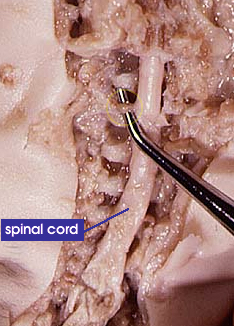Lumbar region

This photo shows a region of the lumbar spinal cord with a spinal nerve isolated with a blunt dissection probe. Spinal nerves are continuous with the spinal cord (on both the left and right of the spinal cord) and run between two successive vertebrae (removed). Thus, in general, there are about as many pairs of spinal nerves as there are vertebrae.
Spinal nerves are large bundles of thousands of axons (from neurons) that project from the spinal cord to the body (muscles, skin, blood vessels, etc.), but not the head. Spinal nerves also contain thousands of axons that originate in the periphery and project to the spinal cord (i.e., two-way traffic of neural information).
Cranial nerves are the equivalent of spinal nerves for the head (and some viscera organs). Neural information enters and/or leaves the brain via these 12 pairs of cranial nerves, e.g., visual sensory information enters the brain via the optic nerve (CN II).
Back to: Nervous system